Child Development, Learning Styles and Taxonomies Assignment
VerifiedAdded on 2022/08/12
|10
|1702
|23
Homework Assignment
AI Summary
This assignment, designed for teacher training, comprehensively addresses child development, learning styles, and taxonomies. It begins by emphasizing the importance of understanding child development for educators, differentiating between growth and development, and outlining the stages of child development. The assignment then delves into various child development theories and their impact on learning. The second part evaluates the concept of learning styles, including visual, aural, verbal, and physical styles, and examines different learning style models, such as 4MAT and Kolb. It explores how to integrate these styles into teaching practices. The third task compares and contrasts learning taxonomies, specifically SOLO and Bloom's taxonomies, discussing their evolution, utilization, and differentiation. The assignment concludes with an analysis of thinking skills, focusing on the application of knowledge, comprehension, and evaluation within the context of Bloom's revised taxonomy, providing a framework for assessing and enhancing students' cognitive abilities.

Running head: CHILD DEVELOPMENT, LEARNING STYLES AND TAXONOMIES
CHILD DEVELOPMENT, LEARNING STYLES AND TAXONOMIES
Name of the Student:
Name of the University:
Author Note:
CHILD DEVELOPMENT, LEARNING STYLES AND TAXONOMIES
Name of the Student:
Name of the University:
Author Note:
Paraphrase This Document
Need a fresh take? Get an instant paraphrase of this document with our AI Paraphraser

1CHILD DEVELOPMENT, LEARNING STYLES AND TAXONOMIES
Task One:
A teacher’s responsibility is to adapt the different learning styles and apply in their
work adequately and appropriately. A teacher has to take upon several duties, but the first and
foremost duty is to develop a student in the right order and should help them in every
possible manner. There are four primary learning styles, such as visual (spatial), aural
(auditory-musical), verbal (linguistic) and physical (kinesthetic).
Therefore, one needs to modify their teaching methods by keeping in mind about the
learning styles like they can ask the students to write an essay and may also ask them to
answer through the oral test. The teachers should provide specific notes, books and even
essential books to prepare them adequately for their examinations.
Being an experienced teacher, it is an honour to prepare a handbook for the new
teachers, who may feel from where they should start thinking about their students and
therefore, they should follow some essential aspects such as:
1. Importance of studying child development for a teacher:
A teacher’s first responsibility is to mould their ways of teaching for every student
and therefore, it is significant to learn about child development so that they can
stimulate their ideas by implementing various theories for improving a child’s process
of learning along with developmental skills1. Every child is different as well as unique
in their own ways, so they need to be treated at a different pace.
2. Difference between growth and development:
1 Bjorklund, D.F. and Causey, K.B., 2017. Children's thinking: Cognitive development and individual
differences. Sage Publications.
Task One:
A teacher’s responsibility is to adapt the different learning styles and apply in their
work adequately and appropriately. A teacher has to take upon several duties, but the first and
foremost duty is to develop a student in the right order and should help them in every
possible manner. There are four primary learning styles, such as visual (spatial), aural
(auditory-musical), verbal (linguistic) and physical (kinesthetic).
Therefore, one needs to modify their teaching methods by keeping in mind about the
learning styles like they can ask the students to write an essay and may also ask them to
answer through the oral test. The teachers should provide specific notes, books and even
essential books to prepare them adequately for their examinations.
Being an experienced teacher, it is an honour to prepare a handbook for the new
teachers, who may feel from where they should start thinking about their students and
therefore, they should follow some essential aspects such as:
1. Importance of studying child development for a teacher:
A teacher’s first responsibility is to mould their ways of teaching for every student
and therefore, it is significant to learn about child development so that they can
stimulate their ideas by implementing various theories for improving a child’s process
of learning along with developmental skills1. Every child is different as well as unique
in their own ways, so they need to be treated at a different pace.
2. Difference between growth and development:
1 Bjorklund, D.F. and Causey, K.B., 2017. Children's thinking: Cognitive development and individual
differences. Sage Publications.

2CHILD DEVELOPMENT, LEARNING STYLES AND TAXONOMIES
Growth can be referred to as the increasing factor in their individual sizes, which is
related to their physical transformation. On the other hand, evolution is defined as the
recognisable progress in their gradual transformation.
3. Stages of child development:
There are three essential stages of child development, which are as follows:
Early childhood, middle childhood and adolescence.
4. Theories of child development:
There are numerous theories by recognisable experts in the field of child
development, such as Piaget’s Cognitive development theory, Freud’s psychosexual
developmental theory and Erikson’s Psychosocial Developmental theory2.
5. Impact of children’s development on their learning:
Many children have been treated in the worst manner during their early childhood and
have shown extreme adverse effects during the process of their development,
including the brain as well as cognitive development3. It may affect their process of
learning in the upcoming years due to child abuse and negligence.
2 Keenan, T., Evans, S. and Crowley, K., 2016. An introduction to child development. Sage.
3 Charlesworth, R., 2013. Understanding child development. Cengage Learning.
Growth can be referred to as the increasing factor in their individual sizes, which is
related to their physical transformation. On the other hand, evolution is defined as the
recognisable progress in their gradual transformation.
3. Stages of child development:
There are three essential stages of child development, which are as follows:
Early childhood, middle childhood and adolescence.
4. Theories of child development:
There are numerous theories by recognisable experts in the field of child
development, such as Piaget’s Cognitive development theory, Freud’s psychosexual
developmental theory and Erikson’s Psychosocial Developmental theory2.
5. Impact of children’s development on their learning:
Many children have been treated in the worst manner during their early childhood and
have shown extreme adverse effects during the process of their development,
including the brain as well as cognitive development3. It may affect their process of
learning in the upcoming years due to child abuse and negligence.
2 Keenan, T., Evans, S. and Crowley, K., 2016. An introduction to child development. Sage.
3 Charlesworth, R., 2013. Understanding child development. Cengage Learning.
⊘ This is a preview!⊘
Do you want full access?
Subscribe today to unlock all pages.

Trusted by 1+ million students worldwide
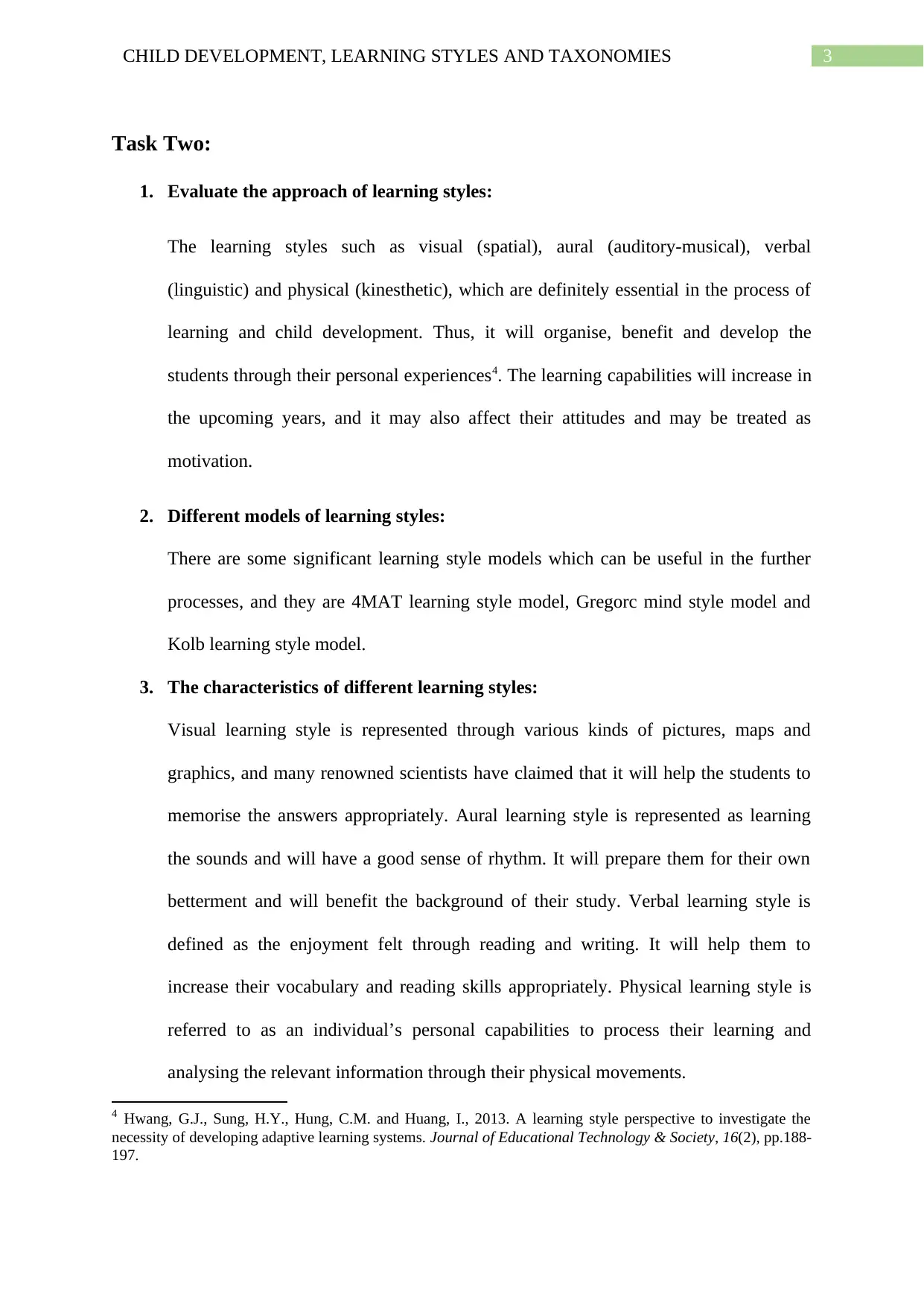
3CHILD DEVELOPMENT, LEARNING STYLES AND TAXONOMIES
Task Two:
1. Evaluate the approach of learning styles:
The learning styles such as visual (spatial), aural (auditory-musical), verbal
(linguistic) and physical (kinesthetic), which are definitely essential in the process of
learning and child development. Thus, it will organise, benefit and develop the
students through their personal experiences4. The learning capabilities will increase in
the upcoming years, and it may also affect their attitudes and may be treated as
motivation.
2. Different models of learning styles:
There are some significant learning style models which can be useful in the further
processes, and they are 4MAT learning style model, Gregorc mind style model and
Kolb learning style model.
3. The characteristics of different learning styles:
Visual learning style is represented through various kinds of pictures, maps and
graphics, and many renowned scientists have claimed that it will help the students to
memorise the answers appropriately. Aural learning style is represented as learning
the sounds and will have a good sense of rhythm. It will prepare them for their own
betterment and will benefit the background of their study. Verbal learning style is
defined as the enjoyment felt through reading and writing. It will help them to
increase their vocabulary and reading skills appropriately. Physical learning style is
referred to as an individual’s personal capabilities to process their learning and
analysing the relevant information through their physical movements.
4 Hwang, G.J., Sung, H.Y., Hung, C.M. and Huang, I., 2013. A learning style perspective to investigate the
necessity of developing adaptive learning systems. Journal of Educational Technology & Society, 16(2), pp.188-
197.
Task Two:
1. Evaluate the approach of learning styles:
The learning styles such as visual (spatial), aural (auditory-musical), verbal
(linguistic) and physical (kinesthetic), which are definitely essential in the process of
learning and child development. Thus, it will organise, benefit and develop the
students through their personal experiences4. The learning capabilities will increase in
the upcoming years, and it may also affect their attitudes and may be treated as
motivation.
2. Different models of learning styles:
There are some significant learning style models which can be useful in the further
processes, and they are 4MAT learning style model, Gregorc mind style model and
Kolb learning style model.
3. The characteristics of different learning styles:
Visual learning style is represented through various kinds of pictures, maps and
graphics, and many renowned scientists have claimed that it will help the students to
memorise the answers appropriately. Aural learning style is represented as learning
the sounds and will have a good sense of rhythm. It will prepare them for their own
betterment and will benefit the background of their study. Verbal learning style is
defined as the enjoyment felt through reading and writing. It will help them to
increase their vocabulary and reading skills appropriately. Physical learning style is
referred to as an individual’s personal capabilities to process their learning and
analysing the relevant information through their physical movements.
4 Hwang, G.J., Sung, H.Y., Hung, C.M. and Huang, I., 2013. A learning style perspective to investigate the
necessity of developing adaptive learning systems. Journal of Educational Technology & Society, 16(2), pp.188-
197.
Paraphrase This Document
Need a fresh take? Get an instant paraphrase of this document with our AI Paraphraser
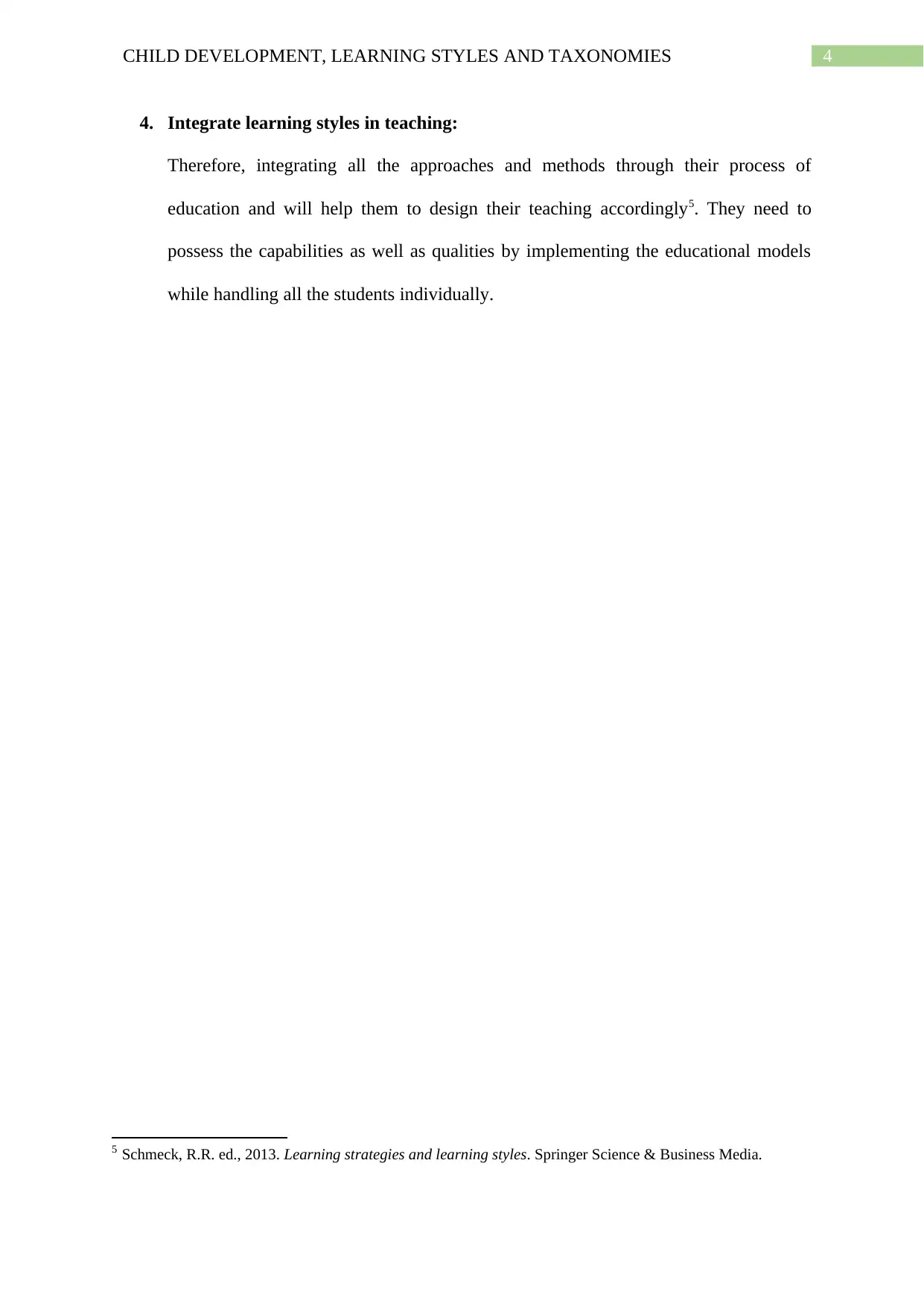
4CHILD DEVELOPMENT, LEARNING STYLES AND TAXONOMIES
4. Integrate learning styles in teaching:
Therefore, integrating all the approaches and methods through their process of
education and will help them to design their teaching accordingly5. They need to
possess the capabilities as well as qualities by implementing the educational models
while handling all the students individually.
5 Schmeck, R.R. ed., 2013. Learning strategies and learning styles. Springer Science & Business Media.
4. Integrate learning styles in teaching:
Therefore, integrating all the approaches and methods through their process of
education and will help them to design their teaching accordingly5. They need to
possess the capabilities as well as qualities by implementing the educational models
while handling all the students individually.
5 Schmeck, R.R. ed., 2013. Learning strategies and learning styles. Springer Science & Business Media.

5CHILD DEVELOPMENT, LEARNING STYLES AND TAXONOMIES
Task Three:
1. Compare and contrast different learning taxonomies:
Learning taxonomy is defined as the process of explaining various kinds of learning
behaviours. Some critical points are required to consider, and they are:
a. Solo taxonomy is referred to as the learning taxonomy that will classify a learner’s
outcome in the field of complexity. It is often used to position high expectations
as well as developing student’s motivation at the original time during the lesson
taught and can be assessed6.
b. On the other hand, Bloom’s taxonomy is developed in order to promote higher
prospects of the thought process in the system of education. It consists of three
taxonomies of learning such as affective, cognitive and psychomotor.
The main objective of solo taxonomy is related on offering guidance to how one
can transfer from one stage to another stage, whereas, Bloom’s taxonomy
thoroughly enhances an individual by incorporating cognitive as well as
knowledge matrix.
2. Evolution of bloom’s taxonomy, utilisation in teaching and learning and
differentiation bloom’s taxonomy and revised bloom’s taxonomy:
The evolution of Bloom’s taxonomy is defined as the model which is related
to the processes of cognitive learning and enhancing their skills in mastering the
desired subjects. The model is named after Benjamin Bloom, who actually took up the
responsibility to form the original taxonomy during the 1950s and 1960s 7.
The model of Bloom’s taxonomy will benefit the teachers to generate a
common language for all the teachers so that they will be able to explain and
6 Biggs, J.B. and Collis, K.F., 2014. Evaluating the quality of learning: The SOLO taxonomy (Structure of the
Observed Learning Outcome). Academic Press.
7 Patton, M.Q., 2018. A historical perspective on the evolution of evaluative thinking. New
Task Three:
1. Compare and contrast different learning taxonomies:
Learning taxonomy is defined as the process of explaining various kinds of learning
behaviours. Some critical points are required to consider, and they are:
a. Solo taxonomy is referred to as the learning taxonomy that will classify a learner’s
outcome in the field of complexity. It is often used to position high expectations
as well as developing student’s motivation at the original time during the lesson
taught and can be assessed6.
b. On the other hand, Bloom’s taxonomy is developed in order to promote higher
prospects of the thought process in the system of education. It consists of three
taxonomies of learning such as affective, cognitive and psychomotor.
The main objective of solo taxonomy is related on offering guidance to how one
can transfer from one stage to another stage, whereas, Bloom’s taxonomy
thoroughly enhances an individual by incorporating cognitive as well as
knowledge matrix.
2. Evolution of bloom’s taxonomy, utilisation in teaching and learning and
differentiation bloom’s taxonomy and revised bloom’s taxonomy:
The evolution of Bloom’s taxonomy is defined as the model which is related
to the processes of cognitive learning and enhancing their skills in mastering the
desired subjects. The model is named after Benjamin Bloom, who actually took up the
responsibility to form the original taxonomy during the 1950s and 1960s 7.
The model of Bloom’s taxonomy will benefit the teachers to generate a
common language for all the teachers so that they will be able to explain and
6 Biggs, J.B. and Collis, K.F., 2014. Evaluating the quality of learning: The SOLO taxonomy (Structure of the
Observed Learning Outcome). Academic Press.
7 Patton, M.Q., 2018. A historical perspective on the evolution of evaluative thinking. New
⊘ This is a preview!⊘
Do you want full access?
Subscribe today to unlock all pages.

Trusted by 1+ million students worldwide
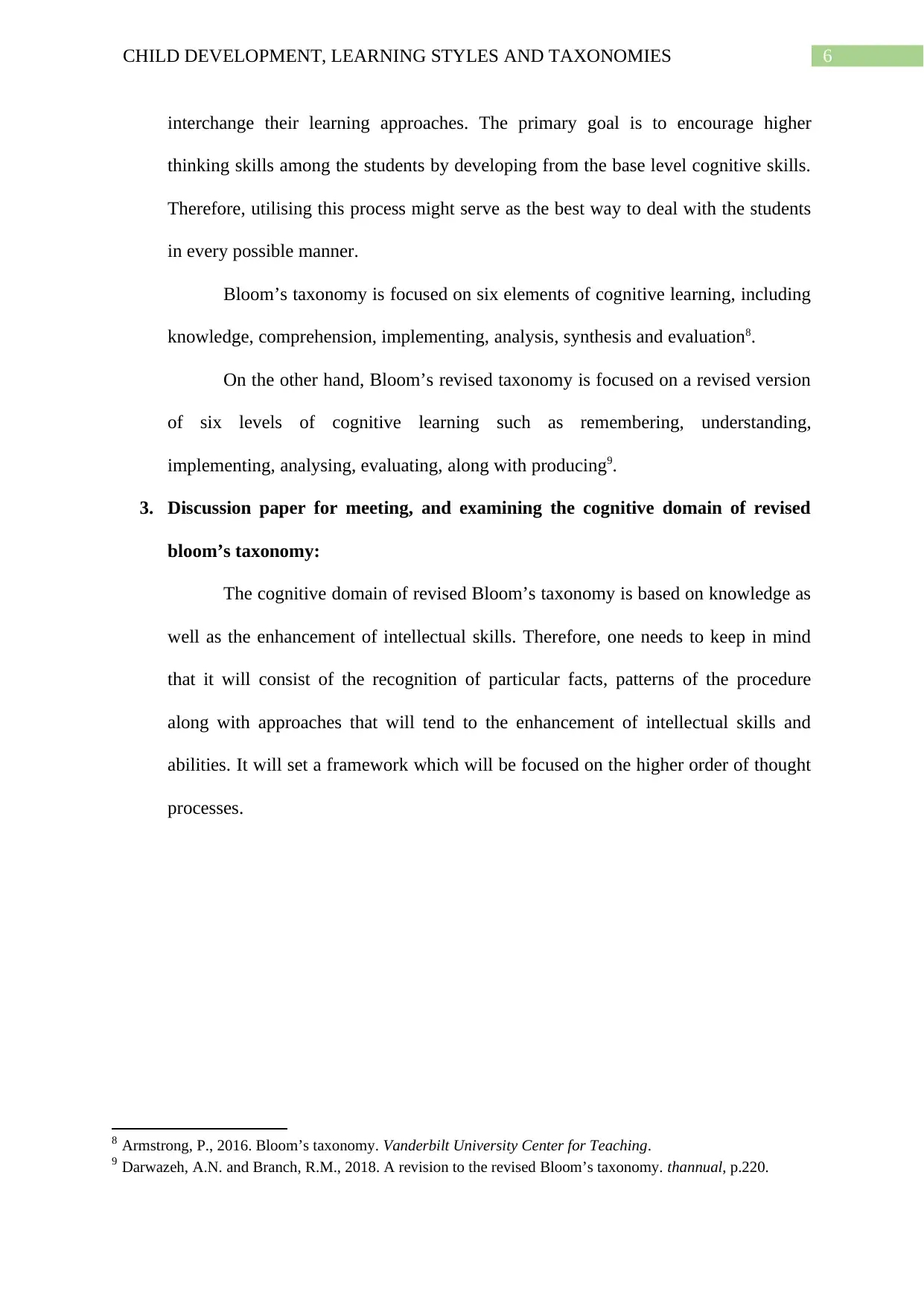
6CHILD DEVELOPMENT, LEARNING STYLES AND TAXONOMIES
interchange their learning approaches. The primary goal is to encourage higher
thinking skills among the students by developing from the base level cognitive skills.
Therefore, utilising this process might serve as the best way to deal with the students
in every possible manner.
Bloom’s taxonomy is focused on six elements of cognitive learning, including
knowledge, comprehension, implementing, analysis, synthesis and evaluation8.
On the other hand, Bloom’s revised taxonomy is focused on a revised version
of six levels of cognitive learning such as remembering, understanding,
implementing, analysing, evaluating, along with producing9.
3. Discussion paper for meeting, and examining the cognitive domain of revised
bloom’s taxonomy:
The cognitive domain of revised Bloom’s taxonomy is based on knowledge as
well as the enhancement of intellectual skills. Therefore, one needs to keep in mind
that it will consist of the recognition of particular facts, patterns of the procedure
along with approaches that will tend to the enhancement of intellectual skills and
abilities. It will set a framework which will be focused on the higher order of thought
processes.
8 Armstrong, P., 2016. Bloom’s taxonomy. Vanderbilt University Center for Teaching.
9 Darwazeh, A.N. and Branch, R.M., 2018. A revision to the revised Bloom’s taxonomy. thannual, p.220.
interchange their learning approaches. The primary goal is to encourage higher
thinking skills among the students by developing from the base level cognitive skills.
Therefore, utilising this process might serve as the best way to deal with the students
in every possible manner.
Bloom’s taxonomy is focused on six elements of cognitive learning, including
knowledge, comprehension, implementing, analysis, synthesis and evaluation8.
On the other hand, Bloom’s revised taxonomy is focused on a revised version
of six levels of cognitive learning such as remembering, understanding,
implementing, analysing, evaluating, along with producing9.
3. Discussion paper for meeting, and examining the cognitive domain of revised
bloom’s taxonomy:
The cognitive domain of revised Bloom’s taxonomy is based on knowledge as
well as the enhancement of intellectual skills. Therefore, one needs to keep in mind
that it will consist of the recognition of particular facts, patterns of the procedure
along with approaches that will tend to the enhancement of intellectual skills and
abilities. It will set a framework which will be focused on the higher order of thought
processes.
8 Armstrong, P., 2016. Bloom’s taxonomy. Vanderbilt University Center for Teaching.
9 Darwazeh, A.N. and Branch, R.M., 2018. A revision to the revised Bloom’s taxonomy. thannual, p.220.
Paraphrase This Document
Need a fresh take? Get an instant paraphrase of this document with our AI Paraphraser
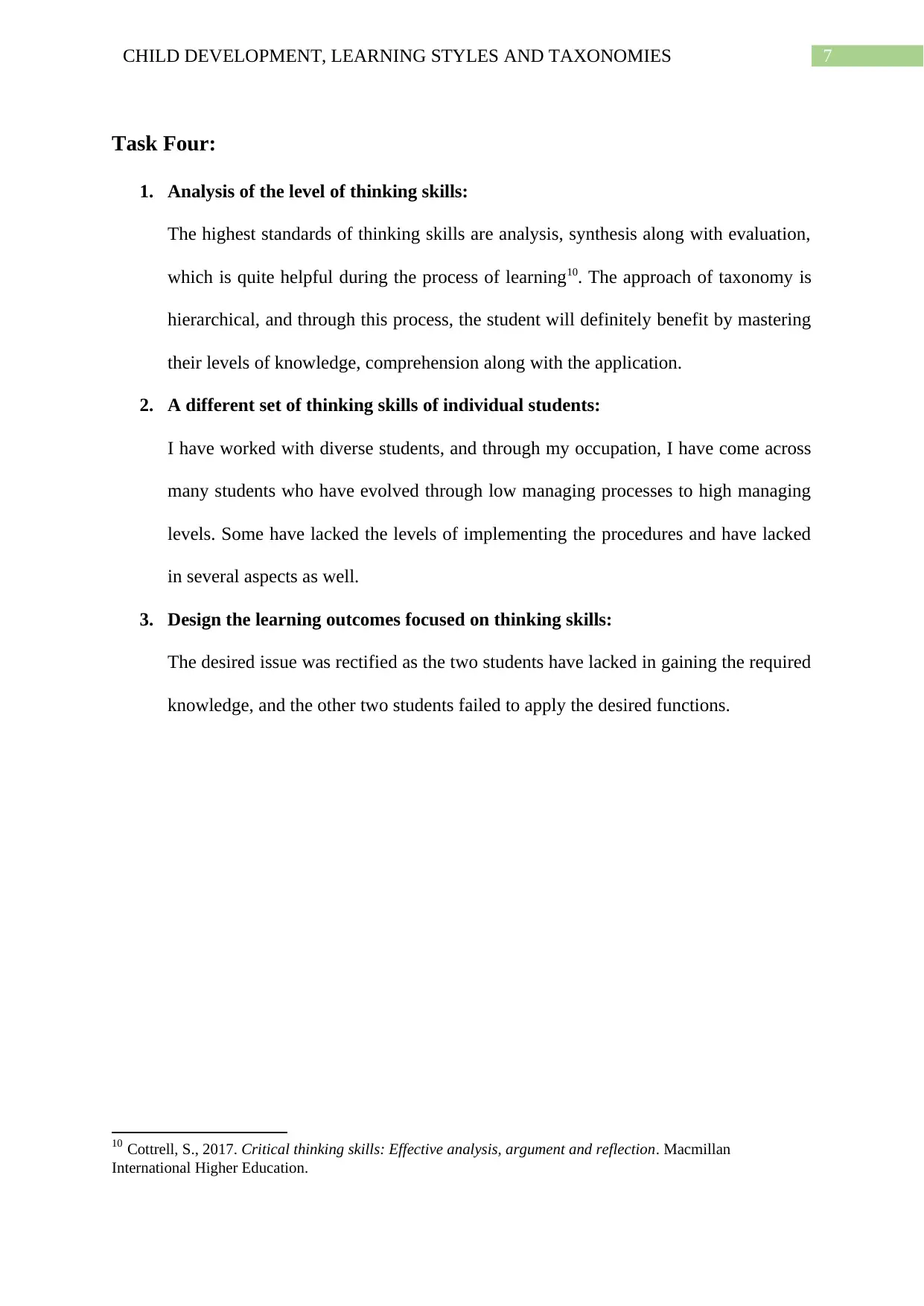
7CHILD DEVELOPMENT, LEARNING STYLES AND TAXONOMIES
Task Four:
1. Analysis of the level of thinking skills:
The highest standards of thinking skills are analysis, synthesis along with evaluation,
which is quite helpful during the process of learning10. The approach of taxonomy is
hierarchical, and through this process, the student will definitely benefit by mastering
their levels of knowledge, comprehension along with the application.
2. A different set of thinking skills of individual students:
I have worked with diverse students, and through my occupation, I have come across
many students who have evolved through low managing processes to high managing
levels. Some have lacked the levels of implementing the procedures and have lacked
in several aspects as well.
3. Design the learning outcomes focused on thinking skills:
The desired issue was rectified as the two students have lacked in gaining the required
knowledge, and the other two students failed to apply the desired functions.
10 Cottrell, S., 2017. Critical thinking skills: Effective analysis, argument and reflection. Macmillan
International Higher Education.
Task Four:
1. Analysis of the level of thinking skills:
The highest standards of thinking skills are analysis, synthesis along with evaluation,
which is quite helpful during the process of learning10. The approach of taxonomy is
hierarchical, and through this process, the student will definitely benefit by mastering
their levels of knowledge, comprehension along with the application.
2. A different set of thinking skills of individual students:
I have worked with diverse students, and through my occupation, I have come across
many students who have evolved through low managing processes to high managing
levels. Some have lacked the levels of implementing the procedures and have lacked
in several aspects as well.
3. Design the learning outcomes focused on thinking skills:
The desired issue was rectified as the two students have lacked in gaining the required
knowledge, and the other two students failed to apply the desired functions.
10 Cottrell, S., 2017. Critical thinking skills: Effective analysis, argument and reflection. Macmillan
International Higher Education.
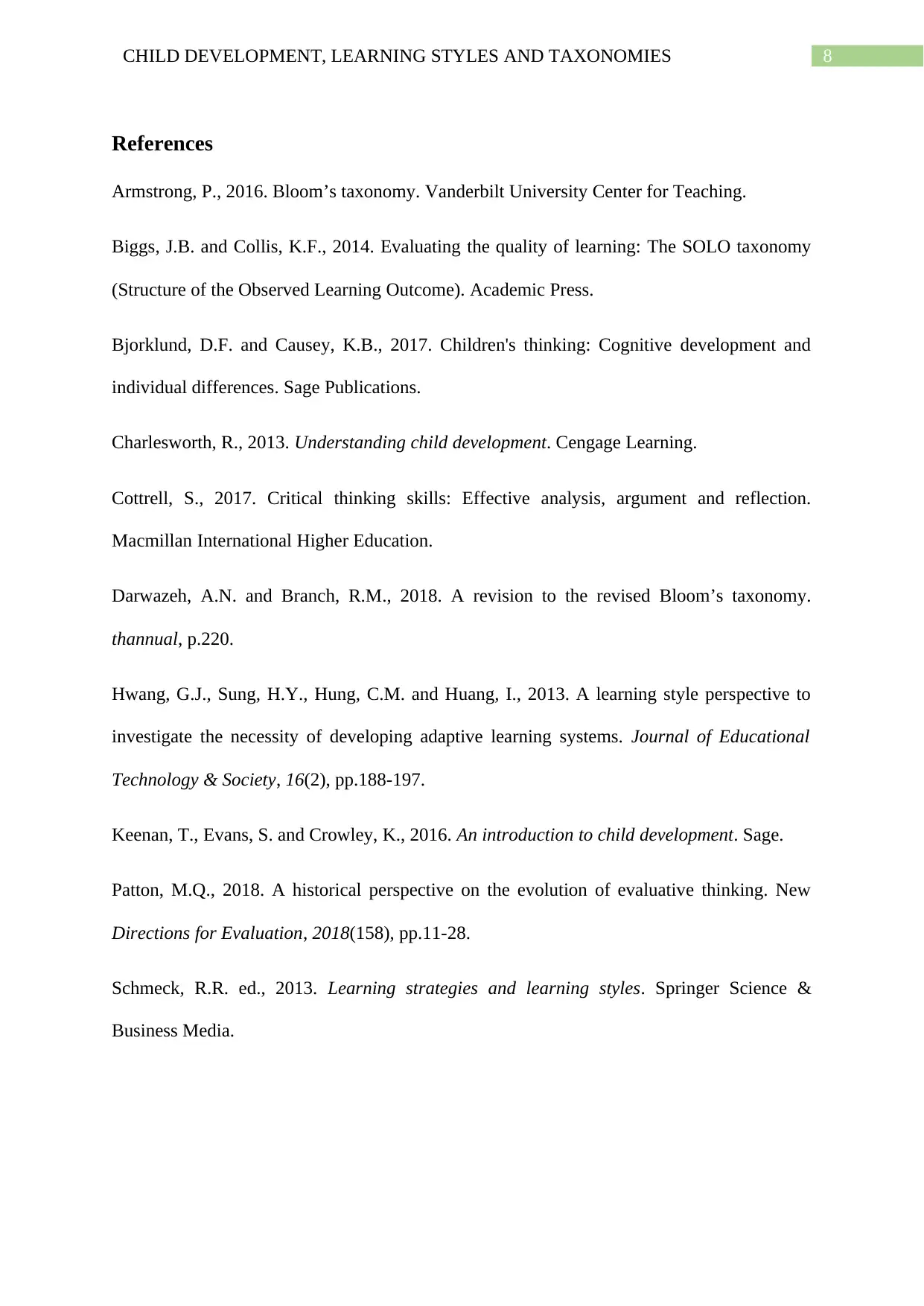
8CHILD DEVELOPMENT, LEARNING STYLES AND TAXONOMIES
References
Armstrong, P., 2016. Bloom’s taxonomy. Vanderbilt University Center for Teaching.
Biggs, J.B. and Collis, K.F., 2014. Evaluating the quality of learning: The SOLO taxonomy
(Structure of the Observed Learning Outcome). Academic Press.
Bjorklund, D.F. and Causey, K.B., 2017. Children's thinking: Cognitive development and
individual differences. Sage Publications.
Charlesworth, R., 2013. Understanding child development. Cengage Learning.
Cottrell, S., 2017. Critical thinking skills: Effective analysis, argument and reflection.
Macmillan International Higher Education.
Darwazeh, A.N. and Branch, R.M., 2018. A revision to the revised Bloom’s taxonomy.
thannual, p.220.
Hwang, G.J., Sung, H.Y., Hung, C.M. and Huang, I., 2013. A learning style perspective to
investigate the necessity of developing adaptive learning systems. Journal of Educational
Technology & Society, 16(2), pp.188-197.
Keenan, T., Evans, S. and Crowley, K., 2016. An introduction to child development. Sage.
Patton, M.Q., 2018. A historical perspective on the evolution of evaluative thinking. New
Directions for Evaluation, 2018(158), pp.11-28.
Schmeck, R.R. ed., 2013. Learning strategies and learning styles. Springer Science &
Business Media.
References
Armstrong, P., 2016. Bloom’s taxonomy. Vanderbilt University Center for Teaching.
Biggs, J.B. and Collis, K.F., 2014. Evaluating the quality of learning: The SOLO taxonomy
(Structure of the Observed Learning Outcome). Academic Press.
Bjorklund, D.F. and Causey, K.B., 2017. Children's thinking: Cognitive development and
individual differences. Sage Publications.
Charlesworth, R., 2013. Understanding child development. Cengage Learning.
Cottrell, S., 2017. Critical thinking skills: Effective analysis, argument and reflection.
Macmillan International Higher Education.
Darwazeh, A.N. and Branch, R.M., 2018. A revision to the revised Bloom’s taxonomy.
thannual, p.220.
Hwang, G.J., Sung, H.Y., Hung, C.M. and Huang, I., 2013. A learning style perspective to
investigate the necessity of developing adaptive learning systems. Journal of Educational
Technology & Society, 16(2), pp.188-197.
Keenan, T., Evans, S. and Crowley, K., 2016. An introduction to child development. Sage.
Patton, M.Q., 2018. A historical perspective on the evolution of evaluative thinking. New
Directions for Evaluation, 2018(158), pp.11-28.
Schmeck, R.R. ed., 2013. Learning strategies and learning styles. Springer Science &
Business Media.
⊘ This is a preview!⊘
Do you want full access?
Subscribe today to unlock all pages.

Trusted by 1+ million students worldwide
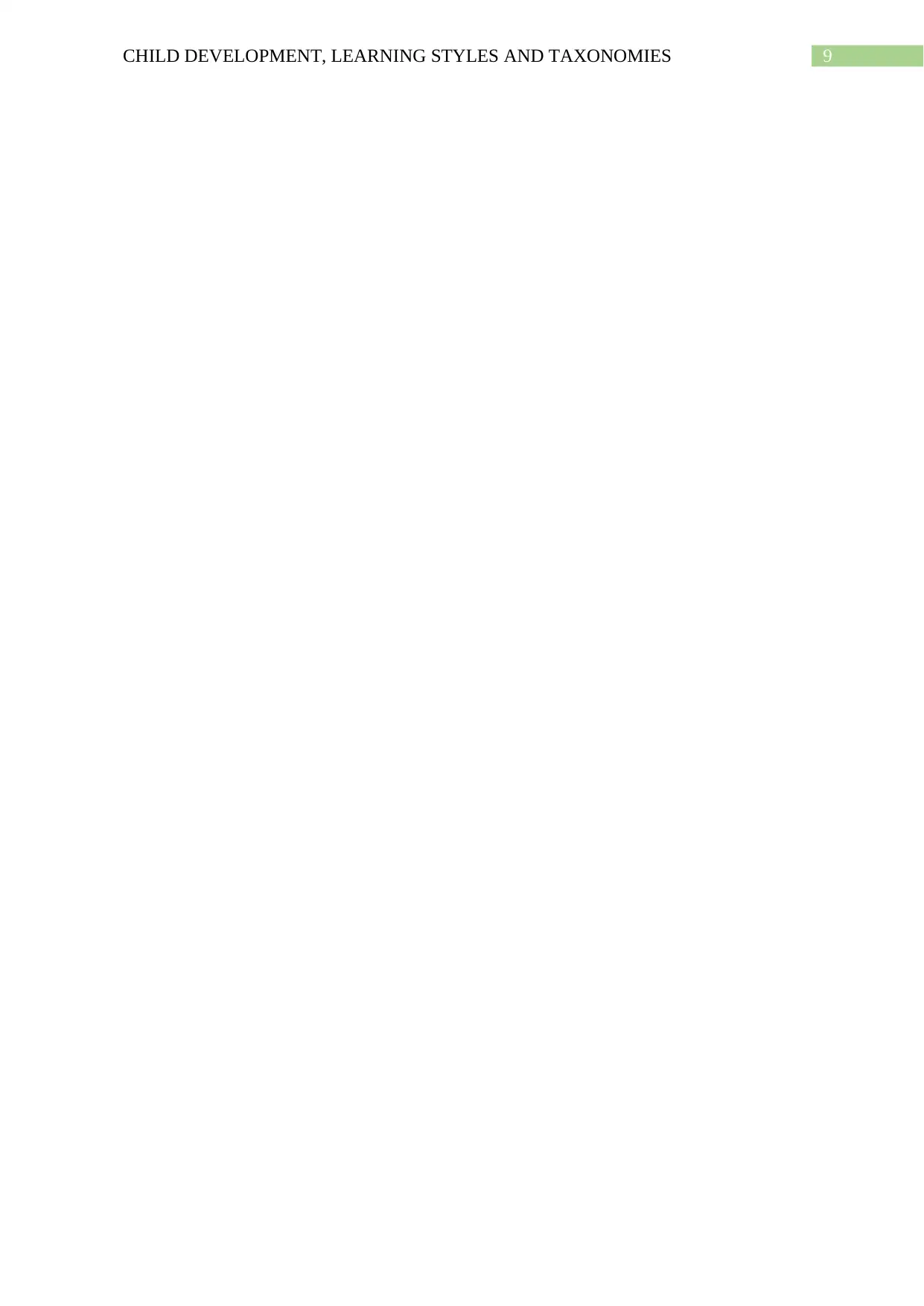
9CHILD DEVELOPMENT, LEARNING STYLES AND TAXONOMIES
1 out of 10
Related Documents
Your All-in-One AI-Powered Toolkit for Academic Success.
+13062052269
info@desklib.com
Available 24*7 on WhatsApp / Email
![[object Object]](/_next/static/media/star-bottom.7253800d.svg)
Unlock your academic potential
Copyright © 2020–2025 A2Z Services. All Rights Reserved. Developed and managed by ZUCOL.





